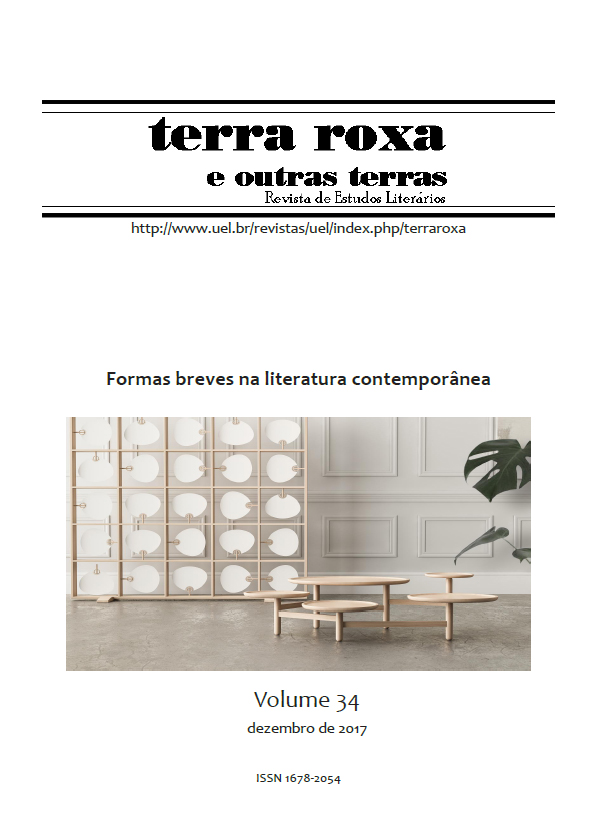Representation of death in mini-short stories in Marcelino Freire's Amar é crime
DOI:
https://doi.org/10.5433/1678-2054.2017v34p7Keywords:
Marcelino Freire, Mini-short story, DeathAbstract
This article analyzes six mini-short stories by Marcelino Freire, a Brazilian contemporary writer who has excelled in this new type of narrative composition. The selected texts are part of Amar é Crime (2010). We sought the representation of death trying to relate it to the brevity, density, irony, symbology and the tension of the narrative as traits dealt by Freire in an usual and original way in in each of his mini-short stories. The state of the art is unanimous in pointing out the conception of brevity combined with density as elements always present in this genre, which has been in a crescendo trend in the Brazilian literary scene, especially after the publication of Os cem menores contos brasileiros do século, an initiative by Marcelino Freire. The analysis carried out in contrast to the literary theory that supports it shows that there is in the mini-short story the intentionality of teasing the reader to search for inferences that confirm the literary power of this type of narrative.Downloads
References
CORTÁZAR, Julio. Valise de cronópio. Trad. João Alexandre Barbosa e Davi Arrigucci Jr. São Paulo: Perspectiva, 2006.
FERRAZ, Flávia Heloísa U. Testemunho e oralidade nos contos de Marcelino Freire: um olhar além da violência. Terra roxa e outras terras: Revista de Estudos Literários, Londrina, v. 15, p 28-35, jun. 2009. Disponível em: http://www.uel.br/revistas/uel/index.php/terraroxa/article/view/24906. Acesso em 20 jan 2017.
FREIRE, Marcelino. Amar é crime. São Paulo: Selo Edith, 2010.
FREIRE, Marcelino. (Org.) Os cem menores contos brasileiros do século. Cotia: Ateliê Editorial, 2004.
LAGMANOVICH, David. Microrrelato. Buenos Aires - Tucumán: Cuadernos de Norte y Sur, 2003.
MARQUES, Ivan. In: FREIRE, Marcelino. Amar é crime. São Paulo: Selo Edith, 2010.
NOGUEROL, Francisca Jimenéz. "Micro-relato y posmodernidad: textos nuevos para um final de milenic". Revista Interamericana de Bibliografia, XLVI, 1-4, 1996, p.49-66. Disponível em: http://www.educoas.org/portal/bdigital/contenido/rib/rib_1996/articulo4/index.aspx?culture=es&navid=201%20. Acesso em 20 jan 2017.
OGLIARI, Ítalo. A poética do conto pós-moderno e a situação do gênero no Brasil. Tese (Doutorado em Letras) - Pontifícia Universidade Católica do Rio Grande do Sul, Porto Alegre, 2010.
PAULINO, Graça et al.. Tipos de textos, modos de leitura. Belo Horizonte: Formato Editorial, 2001.
SANTIAGO, Silviano. Nas malhas da letra. Rio de Janeiro: Rocco, 2002.
SPALDING, Marcelo. Os cem menores contos brasileiros do século e a reinvenção do miniconto na literatura brasileira contemporânea. Dissertação (Mestrado em Literaturas Brasileira, Portuguesa e Luso-africanas) - Universidade Federal do Rio Grande do Sul, Porto Alegre, 2008.
VIEIRA, Miguel Heitor Braga. Formas mínimas: minificção e literatura brasileira contemporânea. Tese (Doutorado em Letras) - Universidade Estadual de Londrina, Londrina, 2012.
ZAVALA, Lauro. Los estudios sobre minificción: Una teoría literaria en lengua española. El conto em red. Revista eletrónica de teoría de la ficcíon breve. Disponível em: http://cuentoenred.xoc.uam.mx Acesso em 20 jan 2017.
Downloads
Published
How to Cite
Issue
Section
License
Copyright (c) 2017 Terra Roxa e Outras Terras: Revista de Estudos Literários

This work is licensed under a Creative Commons Attribution 4.0 International License.
Authors who publish in this journal agree to the following terms:
a) The authors retain the copyright and grant the journal the right of first publication, the work being simultaneously licensed under the Creative Commons Attribution-NonCommercial 4.0 International License, allowing the sharing of the work with acknowledgment of the authorship of the work and initial publication in this journal.
b) Authors are authorized to assume additional contracts separately, for non-exclusive distribution of the version of the work published in this journal (eg, publish in an institutional repository or as a book chapter), with acknowledgment of authorship and initial publication in this journal.
c) Authors are allowed and encouraged to publish and distribute their work online (e.g. in institutional repositories or on their personal page) after the editorial process, as this can generate productive changes as well as increase impact and citation of the published work (See The Effect of Open Access).
d) The authors of the approved works authorize the journal to, after publication, transfer their content for reproduction in content indexers, virtual libraries and the like.
e) The authors assume that the texts submitted for publication are of their original creation, taking full responsibility for their content in case of any objection by third parties.




















